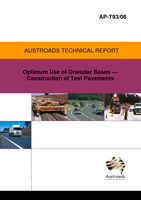Pavement

Optimum Use of Granular Bases: Construction of Test Pavements
- Publication no: AP-T93-08
- ISBN: 978-1-921329-46-3
- Published: 29 February 2008
- PDF (free) Download
Over the last decade a considerable amount of research effort has been focussed on the development of a repeated load triaxial (RLT) test procedure to assist practitioners in the use of natural and marginal unbound base/subbase materials in road pavements. A significant hindrance to the widespread adoption of the RLT test has been the lack of data linking the results of the laboratory test to field performance. In order to address this issue, Austroads established a research project, titled Better Basis for Bases: Optimum Use of Granular Materials . A major component of this research project entails the loading of test pavements with the Accelerated Loading Facility. This report details the construction of the test pavements.
- AP-T98/08 Optimum Use of Granular Bases - Construction of Test Pavements
- 1. INTRODUCTION
- 2. PROJECT BACKGROUND
- 3. MATERIAL SELECTION AND PAVEMENT DESIGN
- 3.1. Material Selection
- 3.2. Layout of Test Pavements
- 3.3. Pavement Design
- 4. CONSTRUCTION OVERVIEW
- 4.1. General Construction Approach
- 4.2. Equipment Used During Pavement Construction
- 4.3. Construction Dates
- 5. CONSTRUCTION OF SUBBASES AND BASES
- 5.1. Removal of Shed Wall Panels
- 5.2. Removal of Existing Material for Pavements A and C
- 5.3. Construction of Cement Treated Subbases for Pavements A and C
- 5.4. Construction of Base for Pavement A
- 5.5. Construction of Base for Pavement C
- 5.6. Removal of Existing Material for Pavements B and D
- 5.7. Construction of Cement Treated Subbases for Pavements B and D
- 5.8. Construction of Base for Pavement B
- 5.9. Construction of Base for Pavement D
- 5.10. Trimming Pavements B, C and D
- 6. MONITORING MOISTURE CHANGES
- 7. SPRAY SEAL DESIGN AND CONSTRUCTION
- 7.1. General
- 7.2. Prime Design
- 7.3. Application of Prime
- 7.4. Seal Design
- 7.5. Placement of Spray Seal
- 8. CONSTRUCTION EVALUATION
- 8.1. Level Thickness Data
- 8.2. Nuclear Density/Moisture Gauge Results
- 8.3. Test Pavement Deflection Results
- 9. CONCLUSIONS AND RECOMMENDATIONS
- REFERENCES
Related publications
Latest Pavement News
